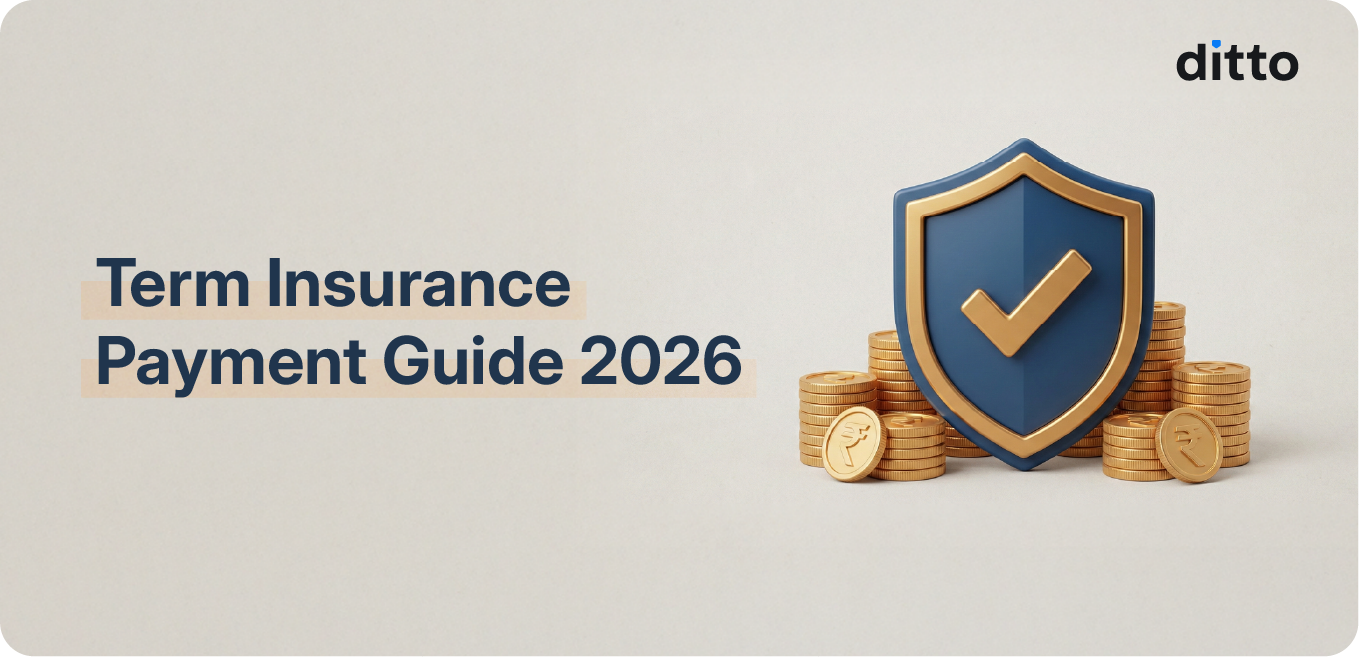Quick Overview
Paying your term insurance premiums is essential, but keeping track of payments can be a hassle, given the multiple premium payment options. At Ditto, we’ve helped thousands of customers navigate the complexities of term insurance and make smarter, hassle-free decisions. In this blog, we’ll walk you through the various payment options available for term insurance premiums, what you’re actually paying for, and how payment frequency can affect costs.
Premium Payment Terms: Regular Pay, Limited Pay, and Single Pay
- Regular Pay
In this option, you continue to pay premiums throughout the entire duration of your policy, usually on an annual, quarterly, semi-annual, or monthly basis. - Limited Pay
Limited Pay allows you to pay premiums for a shorter period while still enjoying coverage for a longer term. For example, you might pay premiums for 5, 10, or 15 years, but your coverage will last for 20, 30, or 40 years. - Single Pay
With Single Pay, you make a one-time lump sum payment at the start of the policy. This eliminates the need for any future payments but generally results in a higher initial cost.
Understanding Premium Payment Frequency
Premium payment frequency refers to how often you pay your term insurance premiums:
- Annual payments are usually the most cost-effective, as insurers often offer lower overall premiums for paying annually.
- Quarterly or semi-annual payments strike a balance by breaking the amount into smaller chunks, though they may cost slightly more than annual payments.
- Monthly payments are the most flexible and budget-friendly in the short term, but they typically end up being the most expensive due to additional processing charges.
If you’d like to understand this in more detail, you can also check out our detailed guide on the same.
Now that we have an overall understanding of how premium payments work in term insurance, let us look at the different methods for making these payments.
Online Payment Methods for Term Insurance
Online payments are the fastest and most convenient way to pay your term insurance premiums. These digital options allow you to pay from anywhere, at any time, and are often processed instantly.
You can choose from multiple options such as credit or debit cards, net banking, EMI via credit card, Bharat Bill Payment System (BBPS), UPI, Electronic Bill Payment Portal (EBPP), wallets, and even WhatsApp.
Steps for Online Payment
Standing Instruction Payment Option for Term Insurance
A standing instruction allows you to automate your premium payments. Once set up, your bank or credit card will automatically deduct the premium on a fixed date each month, quarter, or year. This removes the hassle of remembering payment dates.
How to Set a Standing Instruction?
Note: Since the deduction happens automatically, you need to maintain a sufficient balance in your bank account or credit card to prevent payment failures. Additionally, it offers slightly less control. If you forget to update or modify the instruction when needed, the payment could fail or be delayed.
Cash Or Cheque Payment Option for Term Insurance
For those who prefer a more traditional approach, cash and cheque payments are still valid methods of paying premiums. While these methods are less common now, they are still accepted by many insurers.
How to Pay with Cash or Cheque?
- Cash: Visit your term insurer’s branch and make the payment directly over the counter.
- Cheque: Write a cheque for the premium amount and drop it off at the insurer’s office, or mail it to their registered address.
Note: This method is more time-consuming as it requires visiting the insurer’s office or mailing the cheque, and payments are not processed instantly, which can lead to delays. There is also an added inconvenience and risk involved, such as cheque bounce, loss of cash, or delays due to postal issues.

How To Choose The Right Premium Payment Option? Ditto’s Take
Convenience
Choose the method that fits your lifestyle. If you’re always on the go, an online payment method like UPI or a credit card may work best.
Reliability
Standing instructions are reliable and hassle-free, ensuring timely payments.
Control
If you prefer hands-on control, paying via cheque or cash might feel more comfortable, even though it’s less convenient.
Why Choose Ditto for Term Insurance?
At Ditto, we’ve assisted over 8,00,000 customers with choosing the right insurance policy. Why customers like Aaron below love us:

- No-Spam & No Salesmen
- Rated 4.9/5 on Google Reviews by 15,000+ happy customers
- Backed by Zerodha
- 100% Free Consultation
You can book a FREE consultation. Slots are running out, so make sure you book a call now!
Conclusion
Paying your term insurance premiums doesn’t have to be complicated. Whether you prefer the ease of online payments, the automation of standing instructions, or the traditional methods of cash and cheque, there’s a payment method that suits your needs.
What matters most is matching your premium payment term with your income timeline and balancing today’s affordability with tomorrow’s financial freedom. By understanding your options upfront, you can stay consistently covered without stressing about payments in the years ahead.
Frequently Asked Questions
Last updated on:










